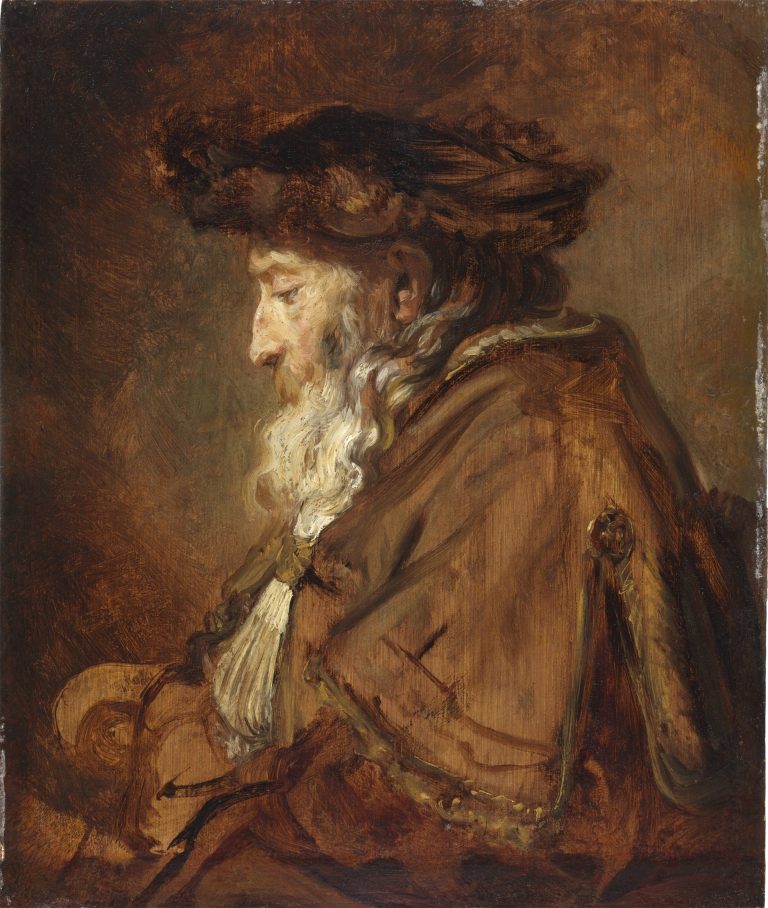This expressively rendered half-length oil sketch of an elderly bearded man depicts the sitter in profile with slightly downcast eyes as he gazes toward the book he holds in his hands. His fur-lined cloak and fur hat are rendered in ocher and brownish tones, with only the shirt, beard and face standing out from their tonal surroundings. Although the man’s physiognomy has been articulated clearly, the body is so sketchily handled and thinly painted that the vertical grain of the panel is visible through the reddish-brown paint. His arms and hands are indicated with only a few rough strokes, giving the work an unfinished appearance.
This freely executed painting, which is known in nine other versions, has been attributed to various artists over the years.1 Wilhelm von Bode published it in 1883 as an autograph work by Rembrandt van Rijn.2 On the basis of a drawing in the Teylers Museum, which very likely was made directly after the present painting (fig 1),3 Horst Gerson attributed both the drawing and the painting (which he knew only from a photograph) to Gerbrand van den Eeckhout (1621–74).4 The painting’s location remained unknown throughout the twentieth century, but when it resurfaced for sale in 2004 it was attributed to Samuel van Hoogstraten (1627–78).5 In 2006 the painting was included in an exhibition at the Jewish Historical Museum in Amsterdam as attributed to Van den Eeckhout.6 Three years later Ernst van de Wetering argued that this small oil sketch was by Rembrandt and was the primary version of the composition.7
The fact that so many copies were made after this oil sketch reinforces the argument that it should be attributed to Rembrandt. The existence of these copies also strongly suggests that this work was viewed as having a special significance in Rembrandt’s workshop, perhaps as a study of a special character type (such as an old man), or as a lighting study, such as Van de Wetering has established for other oil sketches by the master.8
Dates of oil sketches are extremely difficult to determine. A terminus post quem has been established by the dendrochronological analysis of Peter Klein, who determined that the wood support would have been ready for use from 1631 onwards.9 Van de Wetering has argued that the painting can be dated loosely between 1645 and 1655.10 One comparable oil sketch by the master that narrows the chronological framework for this work is Woman Weeping (fig 2).11 Not only do these two small panel paintings have similar dimensions (21.3 × 16.8 cm compared to 22.3 × 18.6 cm), but also in each instance the face is described in more detail than the body and background.12 Woman Weeping presumably dates to around 1644, since it almost certainly served as a preparatory study for Woman Taken in Adultery in London.13 The Leiden Collection sketch of this old man, thus, probably dates to this same period, although in this instance it does not seem to have served as a preliminary study for one of Rembrandt’s larger compositions.
Rembrandt had already had conceived a composition similar to this one early in his career, in a drawing of a seated old man dated 1628.14 Evidently this drawing remained in use in his studio (not uncommon for his drawings), because he revisited the subject matter and pose around 1639 in an elaborate study in pen and ink, now in Paris (fig 3). This pen and ink drawing depicts what appears to be the same model wearing the same costume, including the distinctive hat.
The identification of the old man as a rabbi, which Émile Michel had already proposed in the nineteenth century, is not certain.15 The basis of this identification is the wide flat beret, which Ashkenazi Jews wore in the seventeenth century.16 However, Rembrandt’s follower Salomon Koninck (1609–56) often incorporated exotic features, including Jewish attributes, when depicting learned old men,17 and it remains possible that Rembrandt also intended this kind of open reading for his figure. Koninck, who likely had some contact with the studio in the mid-1640s, also recast Rembrandt’s 1628 drawing into a painted composition,18 and subsequently made a specialty of single-figure depictions of old men in fancy costume. He may well have known the present painted study as well.

